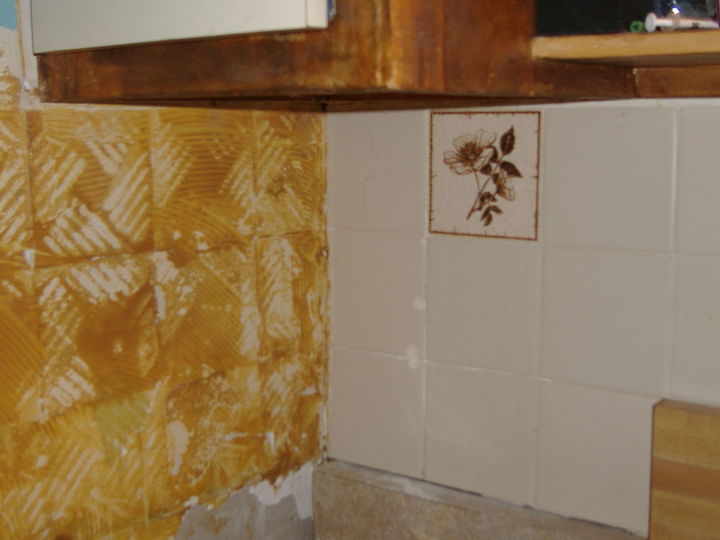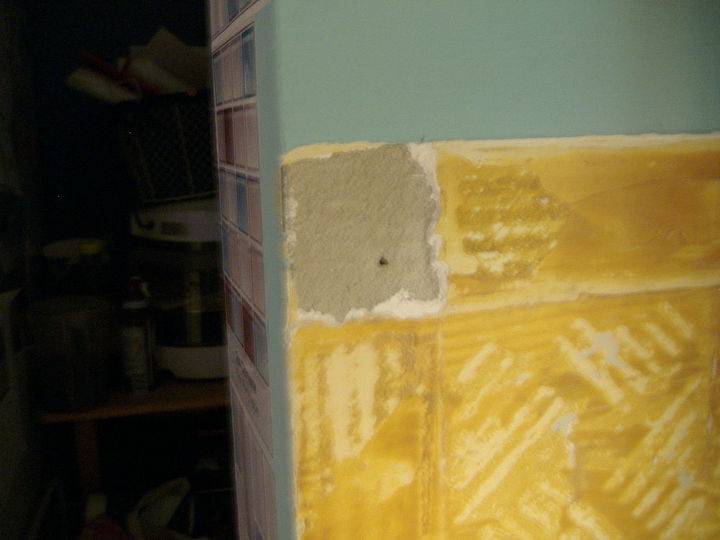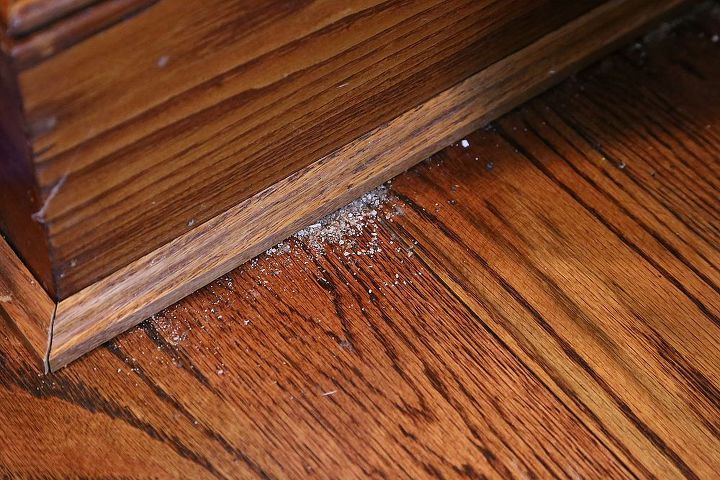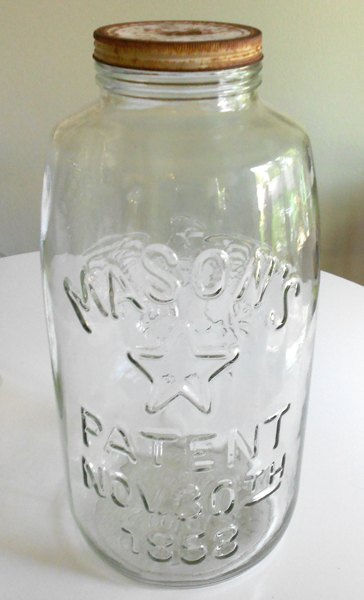What is this orange stuff?

-
I plan on replacing the 4x4 tiles with 12x12 mosaic sheets.
 Linda
on Mar 25, 2012
Helpful Reply
Linda
on Mar 25, 2012
Helpful Reply -
-
glue, it would be in your best interest to get it off before going over it with anything.
Burco Surface & Decor LLC. on Mar 25, 2012
Helpful Reply -
-
Mastic would be a more appropriate name as it was used to set the tile. It looks like from your pic that when you tried to remove some of it it peeled the paper off that part of the dry wall. Ideally setting the new tile on some fresh drywall would be best. But I have know of many instances where a Skim coat of new mastic was used to set over this old stuff.
 KMS Woodworks
on Mar 25, 2012
Helpful Reply
KMS Woodworks
on Mar 25, 2012
Helpful Reply -
-
How would I remove it? Sanding?? It will not wash off and has probably been there for at least 50 years.
 Linda
on Mar 25, 2012
Helpful Reply
Linda
on Mar 25, 2012
Helpful Reply -
-
Sanding could help even it up ( at least to take out the higher bumps) but it would not be practical to try to sand it all away. I would try to knock down the highs and loose bits then skim it with some "setting" type drywall mud. Then after that is full set a light sanding of that then set the new tile with some Arcylpro mastic.
 KMS Woodworks
on Mar 25, 2012
Helpful Reply
KMS Woodworks
on Mar 25, 2012
Helpful Reply -
-
This is a 1950's concrete block house- there is no drywall. It is concrete block with a skim coat of concrete to hide the block lines. Here is a photo of the corner where the most concrete came off with the tile. I am removing each tile with a chisel. I am trying to do as little damage as possible. Some spots the tile is glued on better.
 Linda
on Mar 25, 2012
Helpful Reply
Linda
on Mar 25, 2012
Helpful Reply -
-
put dry wall up over it ... and then do u r kitchen over...
 Melanie L
on Mar 25, 2012
Helpful Reply
Melanie L
on Mar 25, 2012
Helpful Reply -
-
Wow! No dry wall over concrete block? I've never seen anything like that. Our block house was built in the late 60's and our perimeter walls have firring strips w/dry wall attached to them. During our kitchen remodel, we had the same mastic, and it was easier to rip the dry wall off and replace it than to try to smooth the old surface. Smoothing is quite labor intensive.
 Becky H
on Mar 25, 2012
Helpful Reply
Becky H
on Mar 25, 2012
Helpful Reply -
-
Normally mastic can be softened to scrape off by using heat. You could try the hair dryer or a heat gun on it, but after fifty years, it is probably too far gone and brittle such that a cold chisel will be the better removal tool. Whether to patch anything then depends on how bad the surface is. You could go right over it with the new thinset if you are good with a towel, but probably best to smooth it first
 Nichter's Home Services Corp
on Mar 26, 2012
Helpful Reply
Nichter's Home Services Corp
on Mar 26, 2012
Helpful Reply -
-
if you are indeed on concrete, there is no place for mastic or glue behind tile. You really need to go with a crete/mortar based adhesive for your tile. Talk with you local do-it-yourself store and see what advice they have for you.
 Dawn K
on Mar 26, 2012
Helpful Reply
Dawn K
on Mar 26, 2012
Helpful Reply -
-
I've seen that type of building before. It's basically a wing wall inside of the home. Need to be careful when using the chisel, don't want to create big gouges in the block. U can use a sander, suggest you curtain off the room, will be quite messy. Since the glue is directly on the block, all you should need to do is knock down any high spots and what ever is loose.
 Thom S
on Mar 26, 2012
Helpful Reply
Thom S
on Mar 26, 2012
Helpful Reply -
-
The mosiac sheets would be beautiful!! I would knock off the concrete and glue and put a new surface up to tile. Not sure which way I would go for the new surface. Would tile be secure on drywall or would it pull the paper layer off over time?
 Carol B
on Mar 26, 2012
Helpful Reply
Carol B
on Mar 26, 2012
Helpful Reply -
-
Screw cement boards to the concrete. Tile. Do not sand. Some old mastics had asbestos.
 Mark, M
on Mar 26, 2012
Helpful Reply
Mark, M
on Mar 26, 2012
Helpful Reply -
-
Most likely like that pink gunk I've seen in some people's showers and tubs from not cleaning, some sort of mold
 Carol H
on Mar 26, 2012
Helpful Reply
Carol H
on Mar 26, 2012
Helpful Reply -
-
Mark's suggestion is the way I would go...the LAST thing you need to do is release asbestos into the air. Cement boards would give you the even surface you will need for your job.
 Pensacola Accents
on Mar 26, 2012
Helpful Reply
Pensacola Accents
on Mar 26, 2012
Helpful Reply -
-
Linda...smooth it out as best you can then tile over the top..adding any additional "layers" via drywall or cement board will give you too much thickness to do a proper edge detail
 KMS Woodworks
on Mar 26, 2012
Helpful Reply
KMS Woodworks
on Mar 26, 2012
Helpful Reply -
-
It's the glue they always used to use. Very hard to get off, but will be better if you do. Use a sander to get it off
 Rebecca W
on Mar 26, 2012
Helpful Reply
Rebecca W
on Mar 26, 2012
Helpful Reply -
-
Better yet get someone who knows how to get it out of your house.
 Rebecca W
on Mar 26, 2012
Helpful Reply
Rebecca W
on Mar 26, 2012
Helpful Reply -
-
Linda, are you going to remove and replace the counters and small back splash? If so you can start fresh and not worry about adding any thickness to the new back splash with the hardy backer board for tile installation.This will give you a true and level surface for your mosaic tiles. You will use a tile with a radius edge to finish the edge detail
 Lynda B
on Mar 26, 2012
Helpful Reply
Lynda B
on Mar 26, 2012
Helpful Reply -
-
It is mastic and as another said be careful for asbestos was used in about everything prior to the 70's, adhesives you name it was in it... so NO SANDING! I would use cement board over the cement blocks and use cement/concrete anchor screws please wear a mask when drilling then apply the cement boards with screws to avoid dust. If you don't want tiles then use green sheet rock board using the same method but tape seams and mud in screw heads and seams.
 Lynette O
on Mar 26, 2012
Helpful Reply
Lynette O
on Mar 26, 2012
Helpful Reply -
-
Linda, if you want to remove the mastic it would be good to buy a face mask , scrapper with a 4 inch blade (might need a few blades). Then wet down the mastic to keep dust down and slowly scrap the old mastic off the cement walls. You might end up taking the top coating with you as you scrap, but that's okay. You can also score around the outside edge with a utility blade to make sure nothing outside the area comes off by mistake.
 Charles Q
on Mar 26, 2012
Helpful Reply
Charles Q
on Mar 26, 2012
Helpful Reply -
-
I had that in my kitchen when we pulled off the old, very high, formica back splash. It was very difficult to remove so I went with plan B which was to use Venetian Plaster over it instead of tile.
 Nancy S
on Mar 26, 2012
Helpful Reply
Nancy S
on Mar 26, 2012
Helpful Reply -
-
Thanks for all the replies. I am replacing the countertops also, so the area behind the sink can be replaced with drywall or backer board. The area above the stove and next to the sink ( small 24 inch by 18 inch) would be difficult becuase the drywall/backer board would not be flush with the concrete walls. I was kind of hoping to try out that new Bondera Tile installation system, but there were too many surprises behind the tile.
 Linda
on Mar 26, 2012
Helpful Reply
Linda
on Mar 26, 2012
Helpful Reply -
-
its old glue that held up the tile.Be careful most tiles from the 50s have asbestos and you need a protective mask. Not just any mask, but the kind that is used to remove asbestos tiles.
 Tiffany J
on Mar 26, 2012
Helpful Reply
Tiffany J
on Mar 26, 2012
Helpful Reply -
-
I do a lot of remodeling and come across this often. I would knock down as many high spots as possiable and skim coat with 45 or 90 min drywall compound and light sand. Also you can pull the top layer of paper off with the glue and skim coat with 45 or 90 min. mud. If you use 20 min mud in concrete areas it will become hard as a rock, but only mix as much as you can use in about 10-15 min. as it will get hard very fast and is a little hardder to sand. Also if you are using the 20 min. mud on the paster or concrete areas, wet damppen the area first and then apply.
 ClarenceWaggoner Remodeling & Repairs
on Mar 26, 2012
Helpful Reply
ClarenceWaggoner Remodeling & Repairs
on Mar 26, 2012
Helpful Reply -
-
Do not sand it! Use a heat gun and it will scrape off with ease.
 Gabrial G
on Mar 26, 2012
Helpful Reply
Gabrial G
on Mar 26, 2012
Helpful Reply -
-
old glue,
 Diane T
on Mar 26, 2012
Helpful Reply
Diane T
on Mar 26, 2012
Helpful Reply -
-
It's important to remember that you're getting advise from all over the country...but the right answer in PA for instance maybe the wrong one for FL. Adding any kind of drywall here will create a place for mold to take root as the paper will act as a vapor barrier on what is likely an uninsulated home. You're best answer is to leave it alone if it is still well bonded and skim over it with 20 min mud or thinset to achieve the desired thickness taking the new countertops into consideration. Go ahead and get set for the countertops first....skim the walls out some for now but come back and finish once you have the countertops in. Do you have electrical in this wall? If not, you may wish to plan for conduit & incorporate that into the wall design.
 HandyANDY - Handyman & All Repairs, LLC
on Mar 26, 2012
Helpful Reply
HandyANDY - Handyman & All Repairs, LLC
on Mar 26, 2012
Helpful Reply -
-
I am doing a mosaic tile with a butcher block (laminate) counter top. I have been planning this re-do for so long, the counter tops went from stock to special order.
 Linda
on Mar 26, 2012
Helpful Reply
Linda
on Mar 26, 2012
Helpful Reply -
-
it looks exactly like the stuff they use to put up a shower plastic wall with.It is water proof and once you put it on the back of the shower wall it will set up so fast.not sure what to get it off with, but the best thing is to take that part of the wall out.
 Susan B
on Mar 26, 2012
Helpful Reply
Susan B
on Mar 26, 2012
Helpful Reply -
-
As me and handyANDY said, I would skim coat with 45 min. as the 45 min. will give you some working time. I have been doing this for years and it works great. You can not use the pre mixed compound as if it gets wet it will lose its holding power as it turns to a compound. Get the bags of 45 min. and mix about 4 cups at a time and apply it right away. You will have to mix the 45. min. yourself and also damppin the spots that you apply it to as this will hold alot better.
 ClarenceWaggoner Remodeling & Repairs
on Mar 27, 2012
Helpful Reply
ClarenceWaggoner Remodeling & Repairs
on Mar 27, 2012
Helpful Reply -
-
ASBESTOS, ASBESTOS, ASBESTOS !!! Can I say it any louder? Do not diminish the fact it is there. Whatever you do, minimize any dust, wear protective gear. I'm sure its brittle. Do not use heat and scrapers. The light scuff with more mastic over it is the safest approach. THINK SAFETY !
 Amazing Improvements and Garages
on Mar 28, 2012
Helpful Reply
Amazing Improvements and Garages
on Mar 28, 2012
Helpful Reply -
-
It would be pretty easy to have this material tested for asbestos...it is worth the peace of mind in my book. No sense getting all worked up for no reason.
 KMS Woodworks
on Mar 28, 2012
Helpful Reply
KMS Woodworks
on Mar 28, 2012
Helpful Reply -
-
I contacted the previous (original) owner of the house. He said they retiled the kitchen in 1985 and he used Liquid Nails to install the tile. Thanks for the all the answers... I never would have dreamed of installing tile with Liquid Nails.
 Linda
on Mar 28, 2012
Helpful Reply
Linda
on Mar 28, 2012
Helpful Reply -
-
looks like "case closed". I've seen tile set with all kinds of stuff...thin set and mastic make up the great majority...but I have seen tile set with caulk, liquid nails, dry wall mud, roof adhesive and even carpenters glue. Needless to say...some of those failed for obvious reasons...that is why I was there...fixing others mistakes.
 KMS Woodworks
on Mar 28, 2012
Helpful Reply
KMS Woodworks
on Mar 28, 2012
Helpful Reply -
-
That still does not look like liquid nails to me. I would not believe "recollections" on materials used nearly 30 years ago. Be safe, but be sure! Good Luck!
 Amazing Improvements and Garages
on Mar 28, 2012
Helpful Reply
Amazing Improvements and Garages
on Mar 28, 2012
Helpful Reply -
-
Heat does not release asbestos. The friction of sanding surely would. Recollections of the material used could be faulty, but the time frame is most likely true, and there was no longer asbestos in these kind of products at that time
 Nichter's Home Services Corp
on Mar 28, 2012
Helpful Reply
Nichter's Home Services Corp
on Mar 28, 2012
Helpful Reply -
-
I use to do asbestos abatement's. With the house being built in 1957 and not having been remolded since then i would almost guarantee that there is asbestos in the mastic used to hold the tiles. In California a home owner is only allowed to remove 100 sq. feet of asbestos a year without getting a fine. And you must take the same precautions a licensed asbestos contractor would have too. Personally i would go over it with a skim coat or wall board. If you have to go all the way to the ceiling or to the bottom of the upper cabinets to make sure everything turns out flush and even.
 Joseph G
on Mar 28, 2012
Helpful Reply
Joseph G
on Mar 28, 2012
Helpful Reply -
-
My house is in Florida, not California.The kitchen was remodeled in 1985 by the previous home owners (original owners of the house) and I had the bathroom professionally remodeled in1995. With the bath room remodel, the county building inspector said there was no asbestos when he issued the permit to remove the tile in the bathroom. I would be more concerned if I had not been able to contact the original home owner and ask about the product and time frame for the kitchen re-do. Over the years I have found some strange things in this house . I guess I should not have been surprised about the liquid nails. The tiles were in great shape and if I didn't want to update the kitchen, they probably would have stayed stuck on the wall forever.
 Linda
on Mar 28, 2012
Helpful Reply
Linda
on Mar 28, 2012
Helpful Reply -
-
Either nail up some thin Hardie-Backer or just mastic over it and tile away. You cannot get it off now. It sure ain't going to fall off with tile on it. It does need to be reasonable smooth though, so the tiles will lay down over it.
 Elmer
on Mar 30, 2012
Helpful Reply
Elmer
on Mar 30, 2012
Helpful Reply -
-
Yep I thought that stuff look familiar.What we use for our shower wall insert.hope you can get rid of it.
 Susan B
on Mar 30, 2012
Helpful Reply
Susan B
on Mar 30, 2012
Helpful Reply -
-
Inquiring.... love the "shiny diner" in your town. Those skillet dinners ROCK!
 Amazing Improvements and Garages
on Mar 30, 2012
Helpful Reply
Amazing Improvements and Garages
on Mar 30, 2012
Helpful Reply -
-
http://www.asbestostile.org/
 Barbara D
on Apr 03, 2012
Helpful Reply
Barbara D
on Apr 03, 2012
Helpful Reply -
-
http://www.asbestostile.org/are-these-asbestos-tiles/
 Barbara D
on Apr 03, 2012
Helpful Reply
Barbara D
on Apr 03, 2012
Helpful Reply -
-
http://www.asbestosnetwork.com/exposure/ex_homes.htm
 Barbara D
on Apr 03, 2012
Helpful Reply
Barbara D
on Apr 03, 2012
Helpful Reply -
-
I work for a national asbestos removal company. The articles I found and posted are worth researching. You would be amazed about what products of long ago/currently contain asbestos that we are surrounded by or use.
 Barbara D
on Apr 03, 2012
Helpful Reply
Barbara D
on Apr 03, 2012
Helpful Reply -
-
Even some Baby Powder!
 Nichter's Home Services Corp
on Apr 04, 2012
Helpful Reply
Nichter's Home Services Corp
on Apr 04, 2012
Helpful Reply -
Related Discussions
Blackout curtains behind vertical blinds
I have two 6' patio doors, and I want to add blackout curtains to keep the sun/cold out. What is the best way to hang them, and what can I use to push the curtains ba... See more
How to make a balloon garland?
Does anyone know how to make a balloon garland or a balloon arch?
What Is This Stuff?
This "dust" keeps appearing below the molding in one of my first-story rooms. I vacuum it up, it comes back within a few weeks. Any idea what it is? Thank you.
What is best way to attach photos to a burlap stuffed frame
I am trying to attach photos to a burlap frame do I glue it, use pins or tacks there are several different size photographs
Does anyone know what this is?
Just turn them upside down and open them, then insert a roll of paper towel and tada, you have yourself a brand new paper towel holder that is not only beautiful, but... See more
Can anyone identify this vintage wooden crank box?
The item is solid wood, standing aprx. 26" high x 16" wide, no exterior holes or outlets, side crank handle turns four wooden paddles inside with various size holes o... See more
What to put in this huge mason jar?
I have a HUGE mason jar. I would like some ideas on what to put in it for decorations, other than flowers.






